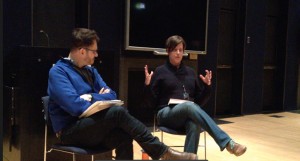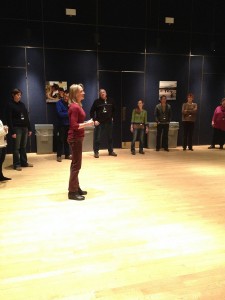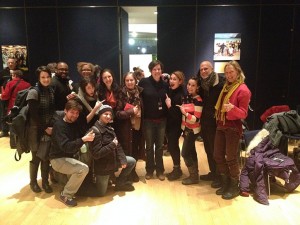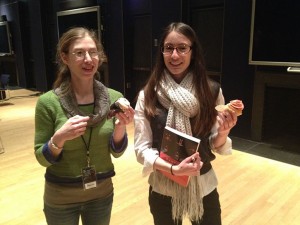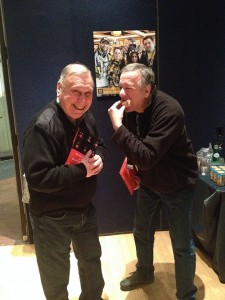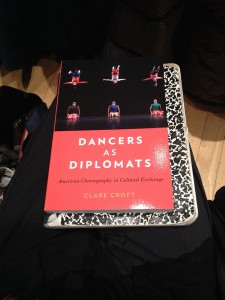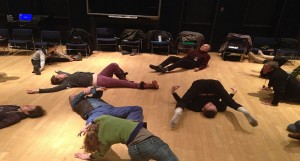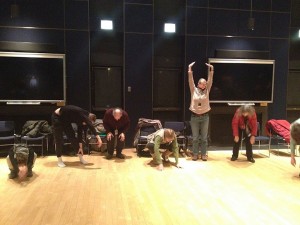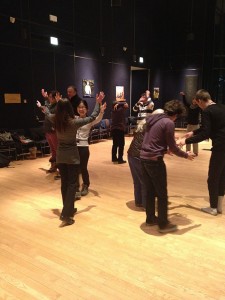UMS Night School: Curious About Dance – Session 3 Recap
Editor’s note: This post is a part of a series of by U-M student and UMS intern Hillary Kooistra, who’s covering our free UMS Night School: Curious About Dance workshop series.
Presenting: The Trisha Brownie Dance Company
After a whirlwind week of dance, we had plenty to discuss during our latest Night School session. We had two special treats on Monday evening: the first was the opportunity to hear Clare Croft, our trusty Night School leader, speak with Jim Leija, UMS Director of Education & Community Engagement, about her new book, Dancers as Diplomats: American Choreography in Cultural Exchange. The second treat, of course, came in the form of cupcakes, which we enjoyed after the discussion. Before we crossed overseas to learn about dance’s contribution to cultural diplomacy, we focused on some exciting moments in American dance, with a reflection on last week’s performances of Confetti Sunrise and the Trisha Brown Dance Company.
Professor Amy Chavasse invites us into the world of Trisha Brown
We were joined on Monday evening by U-M Associate Professor of Dance Amy Chavasse, who guided us through some physicality unique to Trisha Brown. Trisha emphasized the idea of “pure movement” in her work: movement based on mechanical body actions such as bending, straightening, or rotating: stripped of any metaphor or connotation. Trisha built on this essential, pure movement to create the much of the porous, fluid, and surprising choreography we saw this weekend. Amy helped us understand these sensations by inviting us to create and erase edges; set up expectations only to veer in a different direction; and produce gestures that hold specific meaning to us, but appear abstract to the outside eye.
Exploring Trisha Brown’s notion of “pure movement”
I think it is safe to say that after this movement workshop, we are all ready to fly to New York and dance for Trisha Brown. Alas, we had to save our debut as the Trisha Brownie Dance Company (thank you, Charles, for coining the name!) for another day, because there was too much to talk about here in Ann Arbor! We began a rich conversation about this weekend’s performance, acknowledging the elements we saw on the program (costumes, lights, set pieces) as entry points into the dances’ worlds. We also made a nice connection between Trisha Brown, Confetti Sunrise, and the workshop that Anna Martine Whitehead led for us during our last Night School session: thinking about gesture as a mechanism for developing movement and meaning. As we discussed the moments of delight, curiosity, and even discomfort we found in all of the works we watched over the week, we asked ourselves: What are we supposed to care about when watching dance? What do we bring to each performance that may influence our interpretations? How does time collapse and expand as we view performance that holds its own chronology in dance history, as well as in our own experiences?
Clare and Jim discuss Dancers as Diplomats: American Choreography in Cultural Exchange
Each week, I am excited by the ways our interpretations of specific performance works lead to larger discussions about what it means to view and discuss dance. Though we usually approach this broader conversation through performance analysis, this week we were lucky enough to explore ideas behind dance scholarship through Clare’s research on diplomacy in American dance. Her book, which you can buy from UMS for only $20 (excuse my shameless plug!), chronicles dancers’ perspectives of government-sponsored international tours by American dance companies during the early decades of the Cold War and twenty-first century. During the last half of Night School, Clare and Jim sat down to talk about Dancers as Diplomats, divulge some details behind the stories in the book, and answer our questions about the topic.
U-M Department of Dance faculty and students smile with Clare after a conversation about Dancers as Diplomats
Night School students Rebecca and Sam (photo on left) and Ed and Harvey posing with cupcakes and newly purchased copies of Clare’s book!
We have the perfect opportunity to crack this book open, as next week we are off for mid-winter (I just can’t bring myself to say spring) break. I’ll be in Las Vegas, and I have to say I’m more excited about my Cirque du Soleil tickets than I am about the casinos. I guess you can take the girl out of Night School but…
Whether you are travelling or staying in Michigan, I hope you find well-deserved downtime, and perhaps some opportunities to watch, discuss, or even practice dance! We return to the Alumni Center on Monday, March 9th and will be joined by the fantastic Kyle Abraham, whose company Abraham.In.Motion performs at the Power Center that weekend. As a hot, rising choreographer in today’s contemporary dance field, Kyle’s work will provide us with a new lens through which we view performance; it will be a real treat (unfortunately this time without the cupcakes) to have him with us for a session. See you all in two weeks!
Can’t wait to read my copy of Dancers as Diplomats!
Upcoming Events:
Hou Ying and Peng Zheng Dance Performance, Feb. 24, 7pm, U-M Keene Theater (FREE)
Session 3 Resources and Readings:
UMS Night School: Curious About Dance – Session 2 Recap
Editor’s note: This post is a part of a series of by U-M student and UMS intern Hillary Kooistra, who’s covering our free UMS Night School: Curious About Dance workshop series.
It’s Just So…French
We might be facing sub-zero temperatures outside this week, but things were definitely heating up in the U-M Alumni Center on Monday night. We began our second Night School session with a stimulating conversation about Compagnie Non Nova’s Afternoon of a Foehn, then launched into a movement workshop led by newly Chicago-based solo contemporary artist Anna Martine Whitehead. Gestures played a key role in Monday’s session; in both our post-show reflection and Martine’s movement workshop, we found ways to make meaning through the creation, manipulation, and reimagination of repeated motions.
To begin the session, Clare reintroduced our Night School ritual: saying our names while performing a gesture. This time, as a way to kick off the conversation about Compagnie Non Nova, we recalled and produced gestures from the performance. Afternoon of a Foehn runs through next weekend, so those of us who have not yet seen it were instructed to amplify someone else’s gesture. The result? A highly creative game of movement telephone that had us moving in, out, and through our circle in response to one another’s memories of the performance.
We then shared the significance of the gestures we picked, and identified themes and concepts that stuck with us as we watched the performance. What makes a strong visual in performance? How do the rules established in performance alter our expectations of what is to come? How can the performance space change throughout the narrative, and how can it change us? These are only some of the questions that came up as we dissected our own interpretations of the captivating piece of experimental theatre (/dance/ballet/performance art…as we discussed, the category in which it falls is really up to interpretation).
We also landed on a discussion about the conventions of French performance, and how American audiences identify the work produced by European companies as well…European. The hierarchies of performers, sense of pride in claiming a space, and abstraction of narrative are some of the aspects we landed on as, to quote Clare, “just so…French.” For those who plan to head to Skyline High School this weekend, I’d be curious to hear if these concepts stick out to you as you watch the performance.
Warming up for a movement workshop by exploring negative space and interacting with others.
Our discussion of the many ways to approach and interpret Afternoon of a Foehn served as a perfect segway to Martine’s workshop, which centered around the choreographic approach of rethinking movement. She associated this process with Queer Dance, which offers alternative ways to think about gender and sexuality, critique the normal, and imagine other ways to be in the world. Martine will demonstrate this mode of thinking in this week’s performance of Confetti Sunrise, which features the work of Martine and four other queer artists. The workshop served to prepare us for this show, as well as for this weekend’s performance by the Trisha Brown Dance Company.
Throughout the half hour we spent stretching, speaking, moving, and listening, Martine invited us to think: How can gesture make meaning? How can we embellish it, and do it so much that it creates own score? She invited us to act on our instinct, focusing on the concepts of compulsion and desire.
Indulging in stretches during Anna Martine Whitehead’s movement session!
We ended the session in conversation with a partner, during which words were not the primary conversational agents. Responding to the prompt “tell me something that nobody knows,” we performed for our partners a series of gestures that they recalled and repeated back to us. We then manipulated the gestures that we grabbed from our partners (embellished, amplified, repeated, took to a different level…) and created a repeatable sequence–known in dance as a phrase. The exercise encouraged us to think about movement, maybe first as a substitute for words, but then as its own entity whose meaning might veer away from the choreographer’s original narrative.
My fantastic partner, Howard, tells me something that nobody knows using only gestures.
Howard recalls the gestures I conveyed to tell him something that nobody knows.
I was happy to think about this exercise not only from a Queer Dance perspective, but within the context of Trisha Brown. I interned for the company this past summer through UMS’s 21st Century Artist Internship Program, and I was lucky enough to take composition/improvisation classes with Associate Artistic Director Diane Madden while I was there. In class, Diane introduced to me Trisha’s choreographic method of “throwing and catching” movement: Trisha often performed gestures or longer series of movement for her dancers, then asked them to repeat them back to her without ruminating on what they saw. The dancers’ interpretations of her movements ultimately inspired much of her choreography. As I explored this process over the summer, I developed an awareness of how I interpreted movement and how my own movement resonated with others. I was excited to return to this way of working in Night School, and to draw ties between Trisha’s historic work and the innovative contemporary work of Queer Dance artists.
Silent conversations with partners–using gestures to convey meaning.
Speaking of Trisha Brown, we have quite the marathon of dance ahead of us in Ann Arbor this week! Compagnie Non Nova, Confetti Sunrise, Trisha Brown, Dance on Camera…we can have a quadruple bill if we really want to! Remember, if you go to more than one performance this weekend, you are eligible for double stars on your UMS Card. More stars, more dance, more fun.
Next Monday, we will be joined by U-M Associate Professor of Dance Amy Chavasse for our discussion of Confetti Sunrise and Trisha Brown. Then we get to raise a cupcake to Clare in celebration of her new book! She and Jim will be in conversation about Dancers as Diplomats: American Choreography in Cultural Exchange for the latter half of our session, so come hungry for treats and lots of dance talk! (Photocopies of Clare’s first two chapters can be found in our Night School folders, if anyone wants to complete a little pre-reading.)
Events This Weekend:
- Compagnie Non Nova, Afternoon of a Foehn, Feb. 14-21, various times, Skyline High School. TICKET REQUIRED
- Confetti Sunrise, Feb. 18-19, 7:30pm, U-M Duderstadt Center, Video Studio (FREE BUT LIMITED SEATING, FIRST COME FIRST SERVE)
- Dance on Camera Festival, Feb. 21-22, 6pm, U-M Museum of Art, FREE
- Trisha Brown Dance Company Performances, Feb. 21-22, 8pm, Power Center. TICKET REQUIRED
- Related Events:
- Feb. 21: You Can Dance: Trisha Brown Dance Company, Ann Arbor YMCA, 10:45am-12:15pm (SIGN-UP REQUIRED, BEGINS AT 10AM, FIRST COME FIRST SERVE)
- Feb. 21: Tune In: Trisha Brown Dance Company, Power Center Lobby, 7:30-7:45pm (TICKET REQUIRED)
- Feb 21: Opening Night Q&A: Trisha Brown Dance Company, Power Center, post-performance (TICKET REQUIRED)
- Related Events:
Session 2 Resources and Readings:
Dancers as Diplomats by Clare Croft
Introduction
Chapter 2


